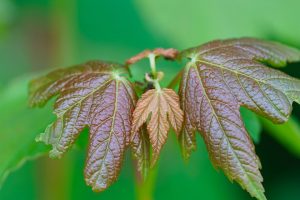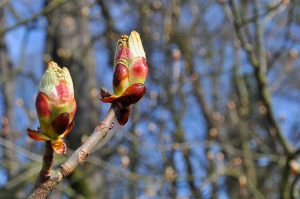 Purdue University - Extension - Forestry and Natural Resources
Purdue University - Extension - Forestry and Natural Resources
Got Nature? Blog
Spring is a time of awakening for our forests as the cold temperatures slowly move to another part of the world and the first crop of buds appear on the trees. These delicate buds are the physical representation of energy stored by the tree over the winter for later use in leaf production. This splurging of energy in springtime is an effort by the tree to produce as many leaves as possible to initiate photosynthesis and carbon assimilation for growth. Unfortunately for the trees, these juicy new leaf bundles are an irresistible temptation for the grazing animals in need of nutrients to replenish those stores lost during winter.
How can the trees thwart these hungry ungulates? One would be led to believe that the sedentary nature of trees renders them defenseless. Fortunately, that is not the case. In a research study published earlier this year, scientists at Leipzig University and the German Centre for Integrative Biodiversity Research (iDiv) have found that European beech (Fagus sylvatica L.) and Sycamore maple (Acer pseudoplatanus L.) trees use chemical warfare to fight back against foraging roe deer (Capreolus capreolus).
In has been established in other forest species that feeding insects stimulate trees to produce chemicals to deter them from further feeding. This study is the first to present data that indicates that a tree species can identify and selectively defend against browsing deer. Manually clipping buds and leaves to simulate storm or mechanized (chainsaw) damage activated the jasmonic acid wound response pathways in both beech and maple but no defensive responses. However, introduction of deer saliva after clipping the buds and leaves led to increased production of salicylic acid (used in humans as a chemical exfoliant, antiseptic, and acne treatment) and tannins (bitter tasting substance used to cure leather and to make ink) in beech leaves with tannins and flavonol (used as an antioxidant in humans and also functions to block bacterial adhesion) being elevated in maple. These chemicals make the leaves and buds distasteful and difficult to digest.
The results of this study open up entirely new lines of research into tree defense responses. What types of responses do other tree species have? Do they produce stronger chemicals? Is deer browse preference based on the presence or absence of a chemical response? Do they wander from tree to tree to browse to avoid the full onslaught of the chemical response? I am certain that those are stories for another day.
Reference Materials
Scientific Literature: Ohse, B., Hammerbacher, A., Seele, C., Meldau, S., Reichelt, M., Ortmann, S., and Wirth, C. 2016. Salivary cues: simulated roe deer browsing induces systemic changes in phytohormones and defense chemistry in wild-grown maple and beech saplings. Functional Ecology doi: 10.1111/1365-2435.12717.
Online site: German Centre for Integrative Biodiversity Research (iDiv) Halle-Jena-Leipzig. “Trees recognize roe deer by saliva: Smart defense mechanisms against browsing.” ScienceDaily. ScienceDaily, 12 September 2016. Last Accessed: October 10, 2016.
Resources:
Nuisance Wildlife, Indiana Department of Natural Resources-Fish and Wildlife
Wildlife Damage, Purdue Extension-Department of Forestry and Natural Resources
Preventing Wildlife Damage – Do You Need a Permit?, The Education Store, Purdue Extension
Internet Center for Wildlife Damage Management (ICWDM), University of Wisconsin-Stevens Point
Shaneka Lawson, USDA Forest Service/HTIRC Research Plant Physiologist/Adjunct Assistant Professor
Purdue University Department of Forestry and Natural Resources

Recent Posts
- Report Spotted Lanternfly – Purdue Landscape Report
Posted: April 10, 2024 in Alert, Forestry, Invasive Insects, Plants, Wildlife, Woodlands - Declining Pines of the White Variety – Purdue Landscape Report
Posted: in Alert, Disease, Forestry, Plants, Wildlife, Woodlands - Are you seeing nests of our state endangered swan? – Wild Bulletin
Posted: April 9, 2024 in Alert, Forestry, How To, Wildlife - Cicadas in Spring! – Purdue Landscape Report
Posted: in Forestry, Plants, Safety, Wildlife - New Deer Impact Toolbox
Posted: April 7, 2024 in Forestry, Land Use, Plants, Publication, Safety, Wildlife, Woodlands - 2024-25 Fishing Guide now available – Wild Bulletin
Posted: April 4, 2024 in Alert, Aquaculture/Fish, Aquatic/Aquaculture Resources, How To, Ponds, Wildlife - Help Research Chronic Wasting Disease – Wild Bulletin
Posted: April 3, 2024 in Disease, Forestry, How To, Safety, Wildlife, Woodlands - Indiana Reptiles and Amphibians – IFWOA Webinar
Posted: April 1, 2024 in Forestry, How To, Webinar, Wildlife, Woodlands - Birding through the Seasons – IFWOA Webinar
Posted: in Forestry, How To, Webinar, Wildlife, Woodlands - Look Out for Invasive Carp in Your Bait Bucket – Wild Bulletin
Posted: March 31, 2024 in Alert, Aquaculture/Fish, Aquatic/Aquaculture Resources, Invasive Animal Species, Wildlife
Archives
Categories
- Alert
- Aquaculture/Fish
- Aquatic/Aquaculture Resources
- Ask the Expert
- Christmas Trees
- Community Development
- Disease
- Drought
- Forestry
- Forests and Street Trees
- Gardening
- Got Nature for Kids
- Great Lakes
- How To
- Invasive Animal Species
- Invasive Insects
- Invasive Plant Species
- Land Use
- Natural Resource Planning
- Nature of Teaching
- Plants
- Podcasts
- Ponds
- Publication
- Safety
- Timber Marketing
- Uncategorized
- Urban Forestry
- Webinar
- Wildlife
- Wood Products/Manufacturing
- Woodland Management Moment
- Woodlands


